Nujiang Lisu Autonomous Prefecture in southwestern China’s Yunnan Province is known for spectacular natural vistas and diverse ethnic cultures. Despite its rich natural and cultural resources, the place had long suffered from extreme poverty. But it leaped thousands of years in a single step to usher in a socialist society from the final phase of primitive society after the founding of the People’s Republic of China in 1949. By the end of last year, more than 550,000 residents in the prefecture had escaped extreme poverty. How did Nujiang people manage to do it? Let’s look at their multi-dimensional approach to shaking off poverty.
Relocation to New Homes
“We used to live in a shabby house on the mountains,” said Ci Asheng, a villager who resided in Shangpa, Fugong County. “But things have improved a lot since we moved into this new community. We like our new homes.” Ci was excited about moving into his new home in a new residential complex just a few miles from his old home. A free apartment was offered to every household below the poverty line.
Tucked away in northwestern Yunnan Province, Nujiang was an extremely poor area with over 98 percent of its land area in rolling mountains and wide valleys, and 76.6 percent of its arable land on steep slopes. Thousands of small communities were scattered in the mountains and on hillsides. The local government of Nujiang prioritized relocating people from shabby houses in remote mountainous areas into nearby towns with well-equipped amenities. By the end of 2020, about 100,000 people in the prefecture had been relocated.
“The ecological systems in these mountains are fragile, and the areas are susceptible to natural disasters,” said Yang Yongzhu, the Head of Fugong County. “By relocating, people can get better access to public services like water, electricity, and roads. It will eliminate the root causes of their poverty.”
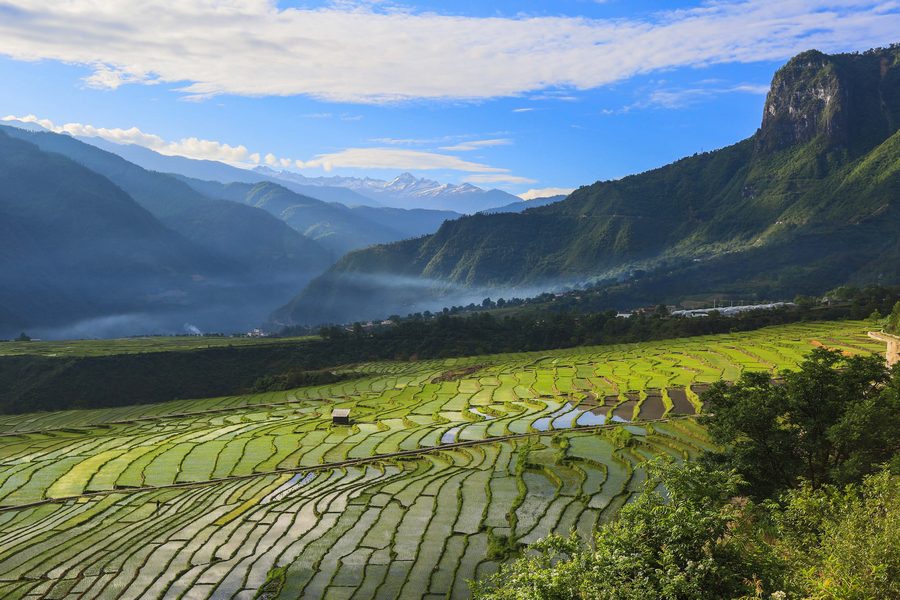
The terraced fields of Nujiang have become a tourist attraction.
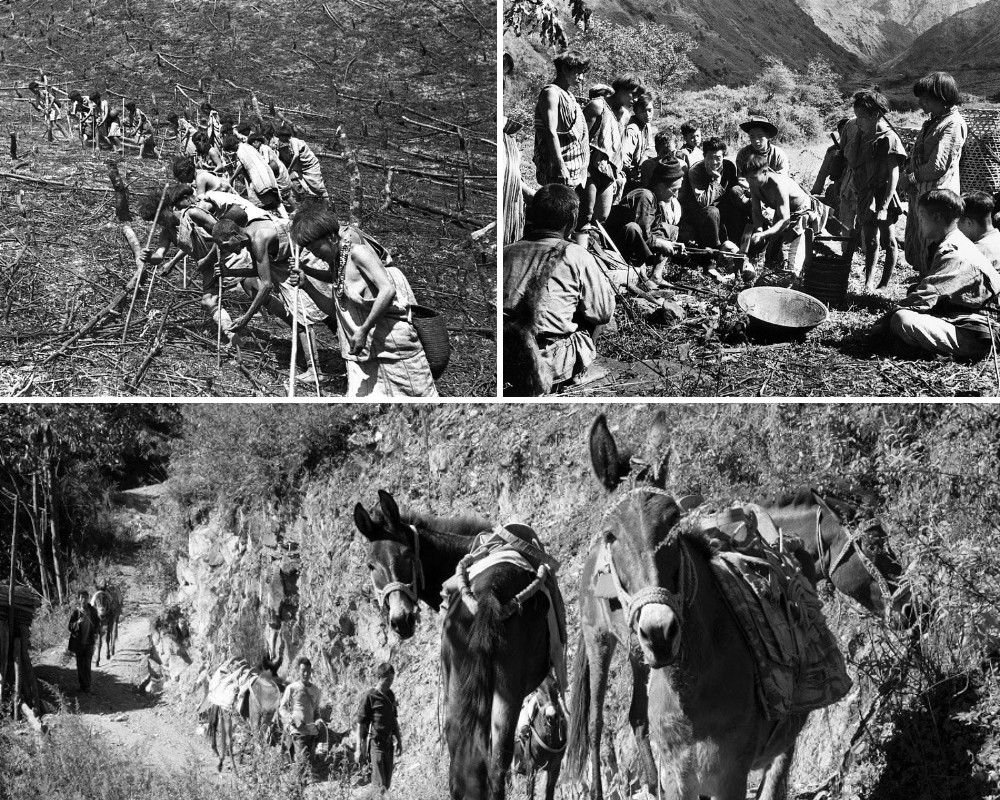
Top left: Slash-and-burn agriculture was once the main farming method in Nujiang. courtesy of Yunnan People’s Publishing House
Top right: Blacksmiths came to teach Dulongjiang people how to forge iron in the 1960s. courtesy of Yunnan People’s Publishing House
Bottom: A still of a documentary recording poverty relief efforts in Laowo Village, Zhongpai Township, Lanping County. by Pu Ya
“Give a man a fish, and you feed him for a day,” goes a universally known proverb. “Teach him how to fish, and you feed him for a lifetime.” Relocation is easy, but ensuring steady income for all relocated people is necessary to prevent a slide back into poverty.
Most local communities have organized training programs on skills like cooking, hairdressing, housekeeping, bamboo weaving, and mechanical repair to help their residents find better ways to earn a living.
Since pairing with Nujiang for poverty relief in 2016 under China’s "East Helps West" poverty alleviation campaign, the southern coastal city of Zhuhai in Guangdong Province has invested 1.43 billion yuan (US$219 million), dispatched 430 officials and technical staff, launched 166 breeding projects, set up 21 workshops, built six resettlement sites, and renovated dilapidated houses at four sites in the area. All these measures ensured smooth relocation and sustained development.
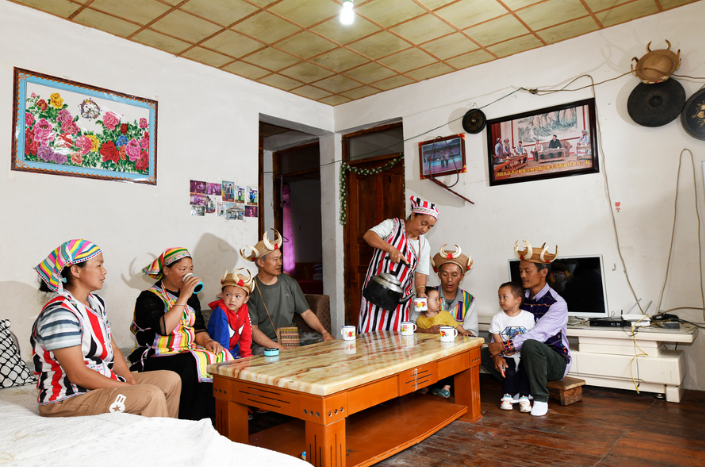
June 2019: Meng Xinchun and his family from the Derung ethnic group in their new home in Maku Village, Dulongjiang Township.
No Child Left Behind
Before 2012, the average education level in Nujiang was still only 7.65 years of school, and 40 percent of local people couldn’t speak Mandarin. At the end of 2018, over 50 percent of the impoverished population in the prefecture had at least primary school education.
“By working as a volunteer in this impoverished prefecture of Yunnan, I can help local students open their eyes and inspire them to embrace a better future,” said Wang Haocheng, one of dozens of volunteers from Renmin University of China in Beijing who came to teach at Lanping Minzu Middle School. The university has launched a long-term program to help locals combat poverty.
Since 2012, China’s education authorities have mobilized over 70 prestigious universities to join the fight against poverty. Those universities sent volunteers, textbooks, and trained professionals to Nujiang to support its basic education.
Education is key to breaking intergenerational transmission of poverty, and children from poor areas must be guaranteed a fair and sound education early in life. Nujiang has made greater efforts towards this goal. As part of these efforts, the local government established several teams of local officials to visit every household in remote villages to identify school-age kids and find ways for them to attend school.
Nujiang has also been working to increase the available vocational training for unemployed youth and the newly transferred rural labor force. It has cooperated with 27 vocational schools in the province and provided education for more than 3,000 junior or high school graduates from poor families.
Ecological Protection
One of the most biodiverse regions of China, Nujiang is teeming with virgin forests, crystal-clear rivers, snow-capped peaks, and rare wildlife. Some communities used to practice hunting and slash-and-burn agriculture. Illegal logging in the 1980s made the ecology worse. In recent years, the sustainable development idea that “lucid waters and lush mountains are invaluable assets” has inspired people to find ways to coexist in harmony with the environment instead of destroying forests and wildlife.
During spring, villagers of Bingfeng in Shangjiang Town, Lushui City, rise early to weed the fields and fertilize Amomum tsaoko. Growing the spice plant has become their primary source of income.
“Its fruits have become our source of wealth,” said Kong Zhongyi, head of the Bingfeng Villagers Committee. “We can earn more by growing Amomum tsaoko than by working elsewhere.”
Amomum tsaoko has proved to be a “cash cow” thanks to higher yield and economic value. Across Nujiang, the total planting area for Amomum tsaoko and other spices has reached 960 square kilometers. In 2019, the per capita income of farmers from forestry in Nujiang was nearly US$463, accounting for more than 40 percent of their per capita disposable income.
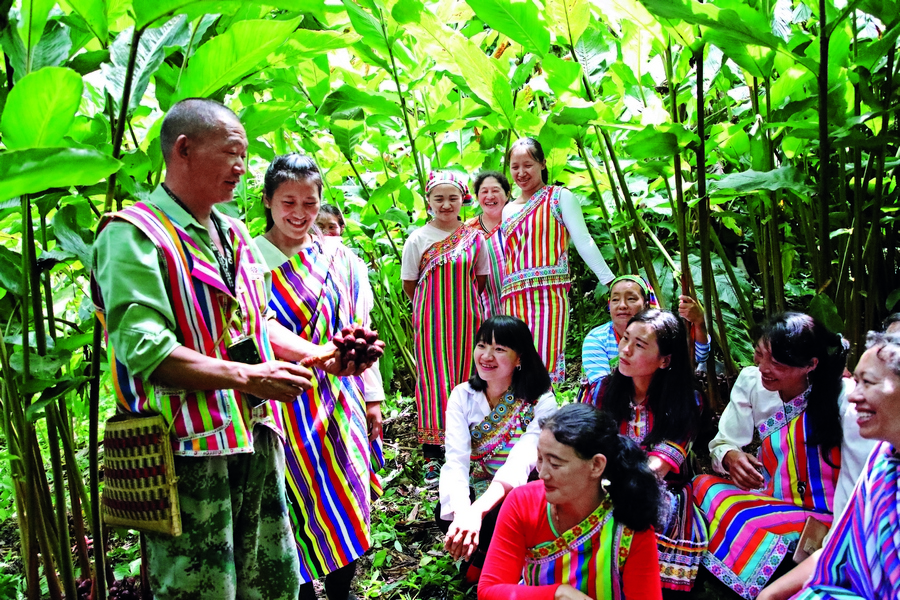
Derung people learn how to plant Amomum tsaoko, a herb that grows at high altitudes and is used as a seasoning spice. The crop, with a high yield and great economic value, has proved to be a cash cow.
Over the years, the forest coverage rate in Nujiang has increased to over 93 percent, and 31,000 formerly unemployed people have been recruited to serve as forest rangers under a project seeking ecological poverty relief. In 2019, the total output value of the forestry and grass industry in the prefecture was 2.3 billion yuan (US$355 million), a year-on-year increase of 17.79 percent. Accelerated green development in the area has not only improved the ecological environment but also produced real economic benefits.
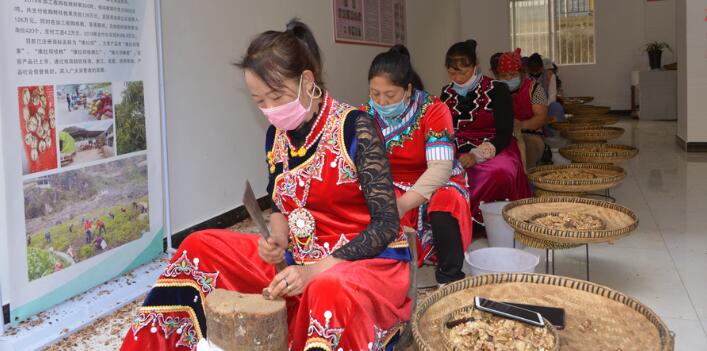
In addition to the new residences, walnut-processing workshops are organized to enable locals to work near home at the resettlement site.
Green Business
“Many tourists are attracted to our secluded natural scenery,” said Gao Jianling, a resident of Bapo Village in Dulongjiang Township, Gongshan County. He bought a house with a courtyard with a loan and opened an inn.
Some Nujiang people started looking to its resources of spectacular landscapes and unique customs formed in the multi-ethnic area to shake off poverty by running B&B businesses and offering sightseeing services and traditional home-made food.
Chala, a mountain village on the eastern side of the Nujiang Valley, once largely relied on farming. It is now home to a thriving B&B industry. Wang Guocai, head of the village, said his childhood memories are sated with poverty. He spent eight hours walking from the village to the high school in town on trails that became muddy whenever it rained.
Much has changed since 2019 when a new highway connecting remote areas of Nujiang opened. The former day-long journey is now just a 10-minute drive.
The improved transportation facilities have made it much easier for tourists to access the village, and more tourists have led to bigger inflow of money. The annual per capita income for local villagers rose from 2,400 yuan (US$387) in 2013 to more than 10,000 yuan (US$1,548) in 2019.
The number of people in Nujiang working in tourism and related industries has surpassed 50,000. Over the years, the eco-tourism business has stabilized the income of many local villagers.
“If I could build mansions across ten thousand square miles, I’d house all the poor and make them beam with smiles,” mused Chinese poet Du Fu over a millennium ago. Throughout history, eradicating poverty has been a tireless pursuit of the Chinese people.
In 2020, China completed the arduous task of eliminating extreme poverty. It was a miracle that will go down in world history. Nujiang is just one of many successful stories to emerge during China’s battle against poverty. Every rural area in China that has successfully eradicated poverty has witnessed the persistence and determination of the Chinese people to change their fate and seize a better life.
Source:
The Nujiang Experience: Poverty to Prosperity by CHINA PICTORIAL
Category
The Nujiang Experience: Poverty to Prosperity
Contributor
The Nujiang Experience: Poverty to Prosperity
Country
Story

